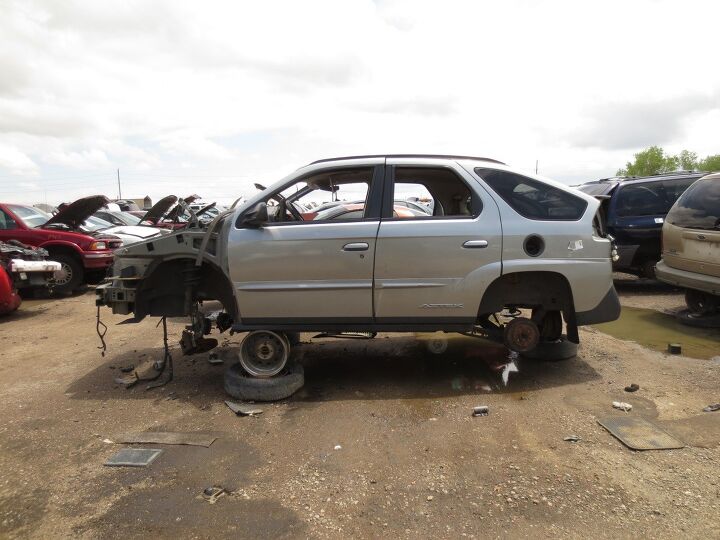#Aztek
Junkyard Find: 2004 Pontiac Aztek
When the Pontiac Aztek concept SUV was unveiled in 1999, it was a bit odd-looking but no more so than the Isuzu VehiCROSS. It looked angular, low, and menacing, which is just how plenty of Americans wanted their truckish vehicles. When the production Aztek appeared as a 2001 model, however, some changes had been made.
Junkyard Find: 2001 Pontiac Aztek AWD
It takes a lot for a 21st-century vehicle to make it into this series, and the Pontiac Aztek has no problem qualifying. Here in Denver, you see Azteks all over the place, presumably because they make sense for the outdoorsy lifestyle that’s so big here (you also see a lot of Vanagon Syncros, presumably because there are lots of masochists here). That means that they’re going to break something not worth fixing and show up at the local self-serve wrecking yard, and I will photograph them. Today’s Junkyard Find Aztek is in excellent condition and appears to have every single option available when new, from heads-up display to air-mattress-inflation compressor. Let’s check it out.
Junkyard Find: 2003 Pontiac Aztek
Now that we’re all about 21st-century Junkyard Finds this week, let’s admire another JF first: the Pontiac Aztek. A popular TV show really ended up muddying the cultural waters around the Aztek, in a process similar to what happened with the DeLorean DMC-12 in the late 1980s, so let’s try to remember back to a time when each of saw our first Aztek and thought what could The General have been thinking?
Up For Sale: The First Production Aztek
Collectors love objects with a link to the darker parts of human history. Whether it is a page of Hitler’s stationary or one of John Wayne Gacy’s clown paintings, if something has a macabre connection, some people simply must have it. If you are one of those people, now is your chance to combine your car hobby with that “other” thing you do by purchasing one of the automotive industry’s most infamous products.
Ask The Best and Brightest: Shouldn't We Shut Up About Styling?
It may not be apparent from the cheerful, distracted way in which I load my TTAC contributions with ridiculous jargon, shocking sexual audacity, and repulsive images of the ghetto, but writing an online auto review is actually a rather tightly woven proposition. One has about a thousand words, give or take a few, in which to convey the essence of a vehicle which has cost hundreds of millions of dollars to develop. There is usually so much data in the press materials that a simple Cliffs Notes version of that data would run to double the permitted review length.
That’s not all. Everybody has access to those materials, so one must be careful to save some room with which to convey accurate, personalized driving impressions. Speaking frankly, there are only three differences between the average denim journOrca (just made that up) and your humble author: I can drive a vehicle beyond four-tenths, I fit in most bucket seats, and I rarely sleep alone at press events. Therefore, in a thousand-word review, I have to set aside a few hundred words to be honest about how the car drives.
You get the point. There’s not a lot of room in the “trunk” of a review. This doesn’t stop most of us in the business from putting junk in that trunk. The “junk” in question consists of vague, uneducated ranting on automotive styling. Click the jump to hear some examples and discuss what should be done.
Remember The Aztek!
When Pontiac’s infamously retina-searing Aztek pops up in popular auto industry analysis, it’s usually as little more than a throwaway punchline. So credit Thebigmoney.com‘s Matthew DeBord for trying to leave the Thesaurus entry for “ugly” out of a recent piece dedicated entirely to one of the great modern styling miscalculations. Unfortunately, his admirable restraint serves only to further a wholly unsupportable thesis:
GM needs to remember the Aztek, because it represents the kind of risk-taking design that the post-bankruptcy firm will need to go forward. The temptation for the New General will be to copy successful market formulas, rather than try to define new market segments.





















Recent Comments